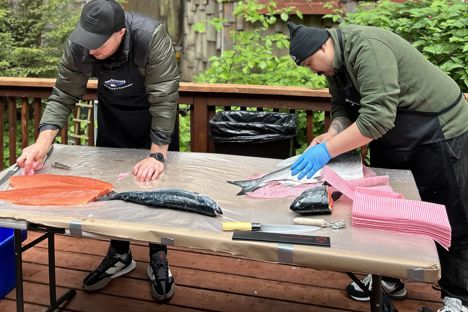
Wild fishing: Alaska’s truly sustainable seafood
The pristine waters of Alaska have long been home to some of the purest seafood in the world. We sent chefs Steven Edwards and Budgie Montoya out to Alaska to learn more.
Wild fishing: Alaska’s truly sustainable seafood
The pristine waters of Alaska have long been home to some of the purest seafood in the world. We sent chefs Steven Edwards and Budgie Montoya out to Alaska to learn more.
Our understanding of how and where we should buy seafood has ballooned in recent years, thanks to a flurry of documentaries and groundswell of advocacy. Though the movement might have had a slower pace than that around meat – thanks in part no doubt to fishing being less immediately visible and misconceptions around infinite supplies – today we have never been more aware of the importance of not only buying quality, but also doing so responsibly. And when it comes to eco-conscious fisheries, there are few better examples than Alaska. Its clean, clear waters have long been renowned for being home to exceptional seafood, boasting five types of salmon, as well as whitefish like pollock, halibut and black cod. It is, in a nutshell, seafood at its natural best, beloved among cooks and chefs around the world. But such high demand hasn’t led to over-fishing and cutting corners – Alaska has remained a haven for truly sustainable fishing, with its practices guided by science to protect what is both a profitable industry and cherished tradition.
We sent chefs Budgie Montoya, of London’s Filipino street food concept Apoy, and Steven Edwards, of etch. in Hove, on a trip with the Alaska Seafood Marketing Institute to experience the state’s culture and fantastic produce first-hand. Over the course of a few days, they learned why Alaska’s icy waters are a haven for excellent seafood, met the people who bring it to shore and got to grips with the process – from fishing and prepping to cooking everything from sockeye salmon to black cod. They did so alongside chefs from around the globe, who blended ingredients and techniques from their own cultures with the freshest of fish, Budgie says. ‘Everyone was in the same boat but had a slightly different background,’ Steven nods. ‘It was inspiring to be with chefs from all around the world using different styles of cooking and seeing how they make up dishes.’
Fishing in Alaska is underpinned by an unwavering commitment to sustainability – it’s so important that it’s even written into the state’s constitution that fish be ‘utilised, developed and maintained on the sustained yield principle’. What that means day-to-day is a science-led approach, governed by strict regulations and quotas, creating one of the most eco-friendly fisheries in the world (it’s illegal to farm fish in Alaska). For chefs, who must be the strictest with their sourcing, it’s a welcome approach. ‘The best part for me was seeing that Alaska seafood is always wild and never farmed,’ Steven agrees. ‘The sustainability is really important. A lot of people talk about it, but just being out there on the fishing boat and seeing it first-hand was amazing. They are going above and beyond to create that sustainability going forward.’ Ultimately, fishing is vital to Alaska, both for its economy (it contributed $5.7 billion in 2019, and employed 62,000 workers) but also to its culture – many of its fishing families have passed the tradition down from generation to generation. ‘It’s so important they have put that into their constitution in Alaska,’ Budgie nods. ‘It’s about keeping it sustainable for generations to come, it’s not just one of those marketing buzzwords. As chefs, we tend to try and shy away from farmed seafood and fish and it was great to see such an abundance of quality wild produce.’
While that emphasis shapes a sustainable industry, it also guarantees the quality of the seafood. After all, we know there are differences between wild and farmed fish. Not only are Alaska’s waters some of the cleanest in the world, but its wild fish also feed on a natural diet – giving them a distinct flavour compared to that of farmed fish – and mature at a natural pace. During their trip, Budgie and Steven had an opportunity to see the fantastic produce up close, including Alaskan salmon (king, sockeye, coho, keta, pink varieties all swim in its waters), whitefish and shellfish. ‘The stand out moment for me on the trip was working with that super fresh produce,’ Steven says. ‘When you work at a restaurant, you get it as fresh as possible, but it’s not literally been caught within the hour. We were preparing the fish there and then, and you just learn a lot from that process.’ Budgie agrees, reflecting on a moment when they were tasked with removing pin bones from a freshly-caught salmon. ‘I didn’t realise the fish was so fresh that it would be difficult to take the bones out,’ he laughs. ‘It was a bit of an eye-opener for me. When it’s that fresh it’s almost impossible – I have never experienced that kind of freshness.’
In Alaska, fishing is much more than an industry; it’s a respected tradition, one which the community understands the importance of protecting. As Budgie and Steven saw, the tight focus on sustainability guarantees the quality and freshness of Alaska’s seafood, and means there will be plentiful supplies for years to come. We know that when it comes to sourcing your seafood, there can be an overwhelming amount of information available. But next time you need to stock up, whether it’s for a dinner party showstopper or mid-week meal, buying seafood from Alaska guarantees both sustainability and stunning quality.


